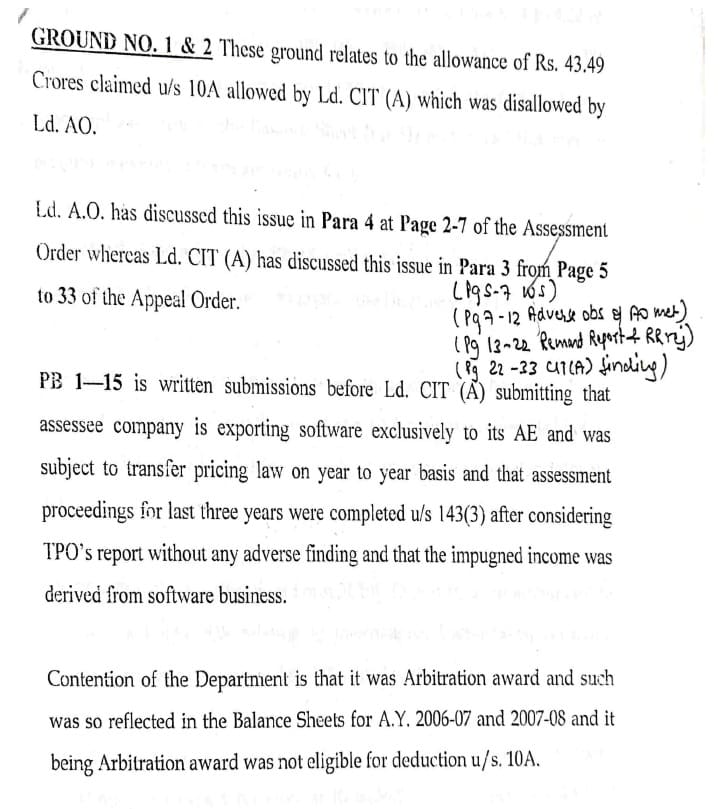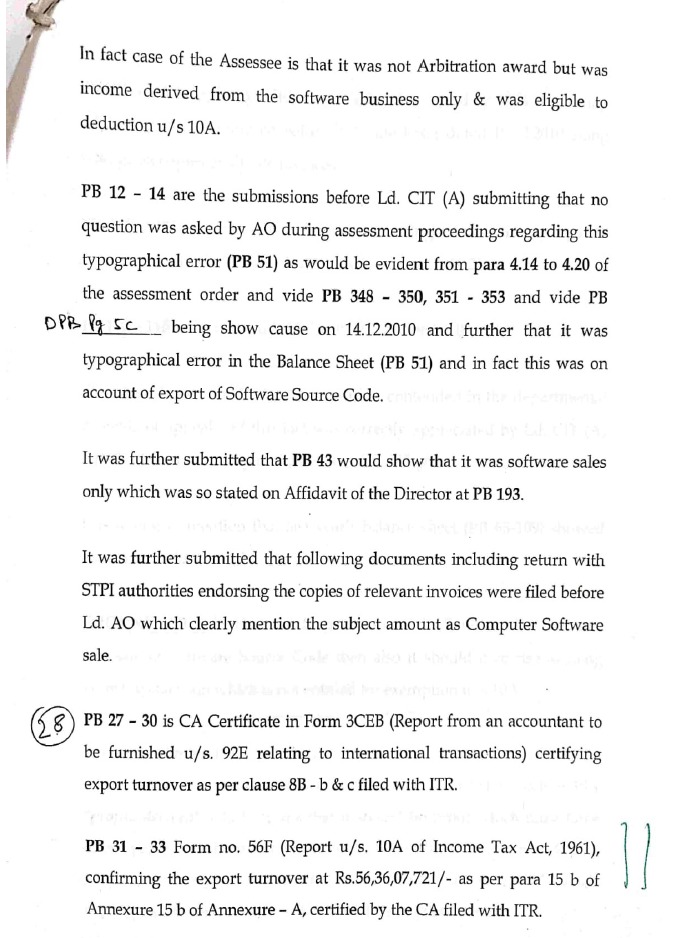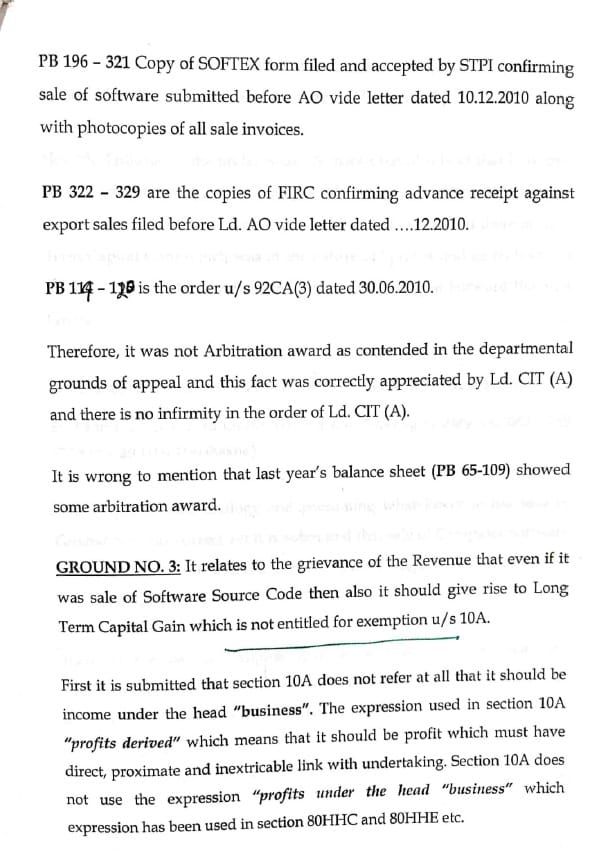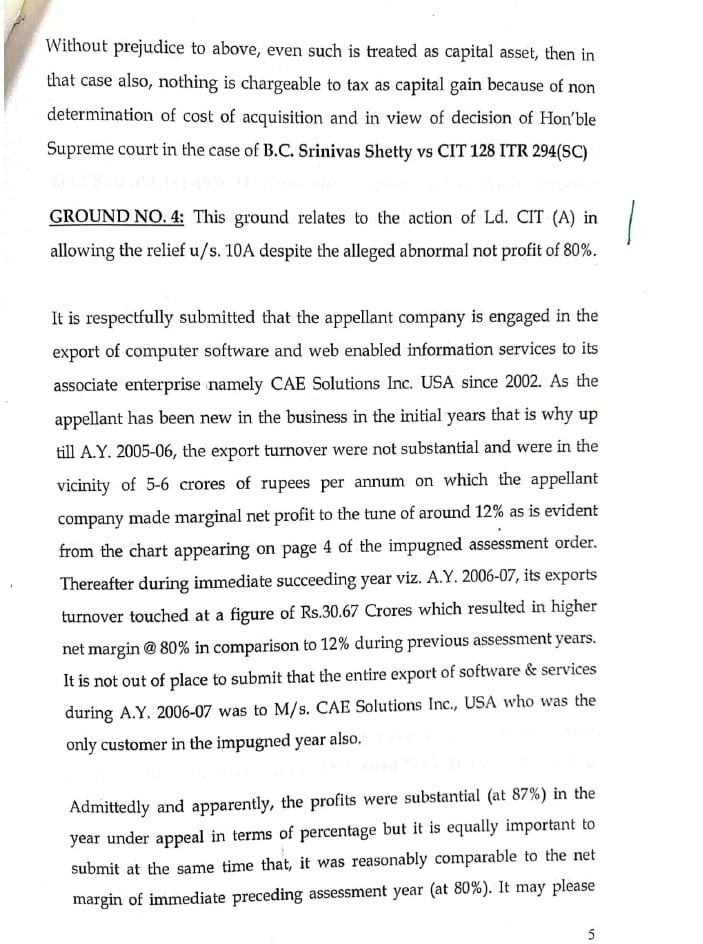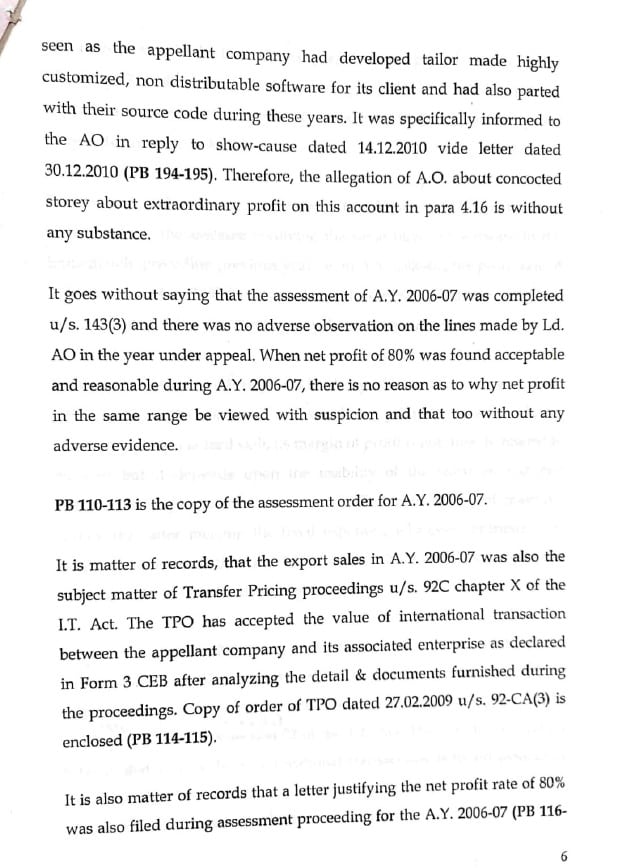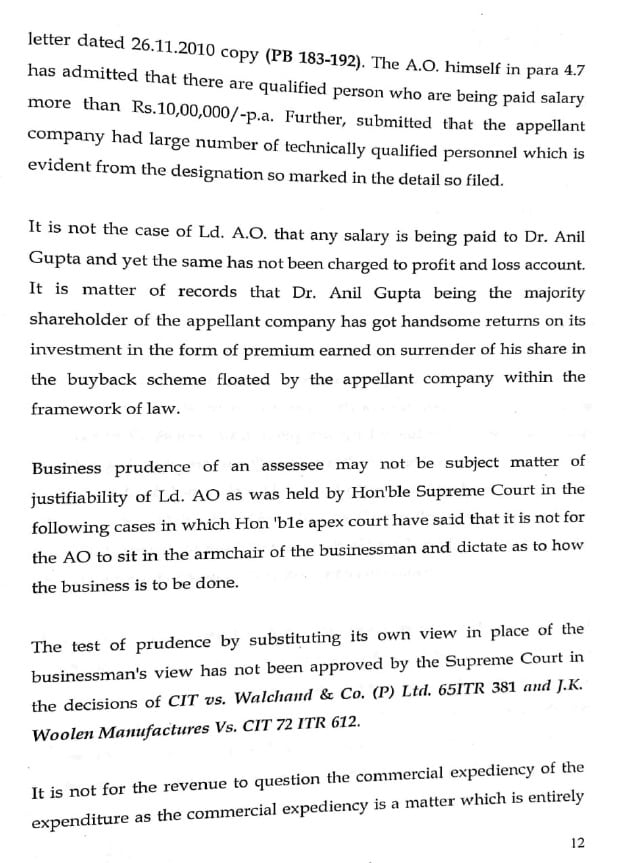10.1. In the last, it is prayed by ld. AR that Ld. CIT(A) has rightly deleted the additions which order deserves to be uphold.
11. Heard the contentions of both the parties and perused the material available on record. From the series of events submitted by Ld. CIT DR, it is seen that in the instant case, issue of exemption u/s 10A was raised by Ld. Pr.CIT in the order passed u/s 263 dated 28.03.2013 which was quashed by the Co-ordinate Bench of Tribunal and further appeal of the Revenue against the said order was dismissed by the Jurisdictional High Court vide its order dated 27.02.2024 in Pr. CIT v. Nuwave E Solutions (P.) Ltd. [ITA No.171 of 2022].
12. Further the assessment for preceding assessment years were completed u/s 143(3) where in AY 2005-06, the assessee has shown net profit margin of 12% and in AY 2006-07, the net profit margin of 80% was declared by the assessee. The revenue had accepted such a sharp increase in the profit margin in the order passed u/s 143(3) of the Act and never doubted the claim of exemption u/s 10A by the assessee. Once the substantial increase in profits from 12% to 80% stood accepted without raising any doubts about the net profit margin achieved by assessee and claimed of exemption u/s 10A on such profits, in the instant year when there were no change in the circumstances neither the nature of business was changed nor the customer is changed and 100% export is made to the same party then increase in net profit from 80% to 87% cannot be questioned solely for the reason that buyer is a controlled party which fact as discussed above, was existed in preceding year also. It is further seen that a reference was made to TPO for determination of ALP of the transactions with AE however, neither in preceding years nor in the year under appeal, TPO has proposed any adjustments and the sales price declared was accepted. These facts were admitted by the AO in his order.
13. Shri Anil Gupta is the largest shareholder of the assessee company and also the proprietor of buyer company. This fcat does not make any difference with respect to sale price charged and development of software at the end of the assessee company where the development was done with the team of experts to whom sufficient salaries as per their job profile were paid and were never doubted by the Revenue. Merely because Shri Anil Gupta had not been compensated for the services rendered, it cannot be said that such arrangement was made to disclose higher profits by the assessee company to claim higher exemption. It is further observed by us that AO has not placed any material on record to hold that sum of INR 25 crores is reasonable compensation to Shri Anil Gupta towards the services rendered by him. It appears that such observations are solely made on conjectures and surmises. Moreover, this observation had not been applied to the computation of income and simply an alternate remarks was given by the AO which are directed to be excluded as have no impact when these observations were made without any supporting material.
14. It is further seen that all the objections raised by the AO have duly been rebutted by the assessee and were appreciated by Ld.CIT(A) in its order. As observed above, it is further seen that the assessee has claimed that there was a “typographical error” due to which sale of software was wrongly classified as “Arbitration Award” in the final accounts and assessee has been successfully demonstrated that it was a typographical error by filing necessary details such as CA certificate in Form 3CEB certifying export turnover, Form 56F i.e. report for claiming exemption u/s 10A of the Act confirming the export turnover of INR 56,36,07,721/-, copy of SOFTEX form filed and accepted by STPI confirming the sale of software, copy of FIRC duly confirming the advance received against the export sales and most important fact that in the order passed by TPO u/s 92CA, export turnover of software of INR 56,36,07,721/- was accepted by the TPO thus now raising doubts by the AO is contrary to the accepted fact by TPO.
15. All these facts, leads to believe that there was a typographical error wherein sale of software was inadvertently stated as “Arbitration Award”. It is also a matter of fact that on one hand, AO has alleged the higher profit when he tried to establish that assessee has claimed excess exemption u/s 10A where AO himself computed the margin of net profits by taking the export turnover at INR 56,36,07,721/-and further in para 4.15 while computing the net profit after reducing the profit of “Arbitration Award”, the AO has not reduced the amount of “Arbitration Award” from the gross export turnover. This clearly shows the bias and contrary approach taken by the AO who at one place too the gross export turnover at INR 56,36,07,721/- and at a later stage himself has treated the part of such turnover as “Arbitration Award” not eligible for exemption u/s 10A of the Act.
16. In view of the above facts and discussion made and further looking to the facts that Revenue has failed to controvert the findings given by Ld. CIT(A) who after appreciating all these facts has deleted the addition made by AO, thus we find no reason to infirmity in the order of Ld. CIT(A). Accordingly, order of Ld. CIT(A) on this issue is upheld. The grounds of appeal Nos. 1 to 4 raised by the Revenue are dismissed.
17. Ground of appeal No.5 is with respect to the deletion of action of the AO in holding the foreign exchange fluctuation as non business receipt and denied the exemption u/s 10A of the Act.
18. Before us, Ld.CIT DR vehemently supported the orders of the AO and submits that foreign exchange fluctuation gain is postexport funds and should not be clubbed with export turnover. He further submits that it is not a profit earned from the export and therefore, cannot be treated as part of export turnover. He thus, prayed for exclusion of the same from the eligible profit for claiming exemption u/s 10A of the Act.
19. On the other hand, Ld. AR vehemently supports the order of Ld. CIT(A) and submits that assessee has gained from foreign exchange fluctuation which is in the regular course of business of export software. Ld.AR further submits that in preceding assessment years, the gain on foreign exchange fluctuation was treated by AO himself as income from export of software eligible for exemption u/s 10A of the Act. Thus, by following the principle of consistency, the same deserves to be held as income from export of turnover in the year under appeal also. He further placed reliance on the submissions made before Ld.CIT(A) in this regard as reproduced in para 4.2 of Ld. CIT(A)’s order which is reproduced herein below for sake of clarity:-
4.2. “The AR of the appellant during the course of appellate proceedings further filed written submissions, the same are reproduced below:-“Ld. AO disallowed the exemption w/s 10A to the extent of Rs. 1,23,33,934/- in respect of foreign exchange fluctuation gain on the ground that gain on account of forex rate fluctuation cannot be considered as profit derived from export as these being the result of post export events or scenario. Further the Ld. A.O. relying upon the decision of Supreme Court Pandian Chemicals v/s. CIT (2003) ITR 278 has alleged that the same cannot be said to have been derived from basic and core activity of export.
It is respectfully submitted that the appellant company is in the business of export of software and is eligible to claim exemption u/s 10A which has been accepted by Ld. AO also in the year under appeal and in earlier years.
During the year under review, the appellant company earned foreign exchange gain amounting to Rs. 1,23,33,934/- on realization of various export invoices as per detail annexed at (PB 330). The appellant company through oversight while filing its original I.T. Return did not include this figure into gross sales credited to Profit & Loss Account. However, while finalizing the balance sheet for the subsequent financial year ended on 31.03.2008, the appellant company realized its mistake and accordingly revised the return alongwith letter dated 23.08.2008 copy at (PB 26) treating the same as part and parcel of net profit derived from export of computer software and claimed deduction u/s 10A of the Act. It goes without saying that the revised return of income stood accepted by Ld. AO and that being so, there was no occasion for Ld. AO to deny the benefit of impugned foreign exchange gain.
As per provisions of sub-section (4) of section 10A which reads as under-
(4) For the purposes of sub-sections (1) and (1A) the profits derived from export of articles or things or computer software shall be the amount which bears to the profits of the business of the under taking, the same proportion as the export turnover in respect of such articles or things or computer software bears to the total turnover of the business carried on by the undertaking” Therefore, u/s 10A deduction of profit & gain derived by an undertaking from export of articles or things or computer software is admissible. The Hon’ble Supreme Court in the case of Pandian Chemicals (supra) has define the word “derived from” in section 80 HH of the 1.T. Act must be understood as something which has direct or immediate nexus with assessee’s industrial undertaking. The Hon’ble ITAT Mumbai Bench in the case of Renaissance Jewellery P. Ltd. v. ITO [2007] 289 ITR (AT) 65 (Mum) has held that the crucial words “derived from” there is hardly any material difference between the legal requirements of section 80HH and section 10A.
During the year under review, the appellant booked export sales on the basis of a prevailing rate of exchange on the date of invoices. However, later on it realized a different sum in Indian rupees as sale proceeds as per detail at (PB 330), the net excess or the shortfall is booked as foreign exchange gain as it is does not have a different character from the export turnover and it is also part of export profits.
In the case of C IT v/s. Sony India Pvt. Ltd. [2009] 315 ITR (A.T.) 0150-[ITAT-
Delhi] relying upon DCIT v/s. K. K. Doshi and Co.
[2000] 245 ITR 849 (Bom) held Any profit or loss as a result of foreign exchange fluctuation ultimately goes to increase or reduce the figure of export turnover recorded initially by the assessee in its books of account. The basic character of receipt on account of foreign exchange thus remains the same. Therefore income from foreign currency fluctuation is part of export turnover and is a sort of additional sales price. Therefore foreign exchange gain is includible in the profits eligible for deduction under section 104/10B of the Act. Further reliance can be placed on the following judicial pronouncements:-
(a) Smt. Sujatha Grover v. Deputy CIT (2002) 74 TTJ 347 (Delhi)
(b) Priyanka Gems v. Asst. CIT [2005] 94 TTJ 557 (And)
(c) CIT v. Rane (Madras) Ltd. [1999] 238 ITR 377 (Mad), where even a forward contract in foreign exchange, which had nexus with the export of goods could be treated as relating to the activity eligible for deduction in the context of sections 80E and 80-I.
In fact, the case of the appellant is also covered by the decision of Hon’ble Supreme Court in the case of CIT v/s. Woodward Governor P Ltd312 ITR 254 (SC).
It is pertinent to mention here that gain on account of foreign exchange during A.Y. 2006-07 has been accepted as export profit u/s 143(3) of the Act. Copy of I.T. Assessment for the A.Y. 2006-07 and profit & loss account as on 31.03.2006 are enclosed at (PB 101-113 & 99) respectively.
Therefore, it is prayed that deduction w/s 104 on account of foreign exchange gain as claimed by the assessee in the revised return may please be allowed.”
20. Heard the contentions of both the parties and perused the material available on record. From the perusal of the order of Ld.CIT(A), it is seen that Ld.CIT(A) based his findings that foreign exchange fluctuation gain is income from software export and eligible for exemption u/s 10A by placing reliance on various judgements including the judgements of Hon’ble Supreme Court in the case of CIT v. Woodward Governor (P.) Ltd. 312 ITR 254 (SC) and further ton he decision of coordinate bench of Tribunal in the case of CIT v. Sony India Pvt. Ltd. [2009] 315 ITR (A.T.) 0150-[ITAT-Delhi). The relevant observations of Ld. CIT(A) in para 4.3 are as under:-
4.3. “I have considered the assessment order, written submissions filed by the counsel and judicial pronouncements as relied upon. Admittedly, the appellant being in the business of export of software is eligible to claim exemption u/s 10A. Whenever, the exports are made, the invoices are raised in USD and booked into the financial books in INR at the rate prevailing as on date of invoice. However, as the export invoices are realized subsequently at a different price due to change in exchange rate of USD, net excess or short fall has been booked by the assessee as foreign exchange gain. The assessee has filed detailed calculation of foreign exchange gain realized by it. The A.O. in the assessment order has observed that any gain or loss on account of fluctuation in foreign exchange rate is post export event and not out of the core activity of export. The contention of the A.O. is not sustainable under the law as the profit on account of foreign exchange gain is directly referable to the articles and things exported by the assessee.
Such profits are, therefore, in the same nature as the sale proceeds and there is no reason why deduction under section 10A should not be allowed in respect of such exchange gain. Reliance is placed on the following judicial pronouncements:-
| • | | CIT v/s. Woodward Governor P Ltd.312 ITR 254 (SC). (SC) |
| • | | CIT v/s. Sony India Pvt. Ltd. [2009] 315 ITR (A. T.) 0150- [ITAT-Delhi) |
| • | | Renaissance Jewellery P. Ltd. v. ITO [2007] 289 ITR (AT) 65 (Mum) |
| • | | Priyanka Gems v. Asst. CIT [2005] 94 TTJ 557 (Ahd) |
| • | | Smt. Sujatha Grover v. Deputy CIT [2002] 74 TTJ 347 (Delhi) |
| • | | DCIT v/s. K. K. Doshi and Co. [2000] 245 ITR 849 (Bom) |
| • | | CIT v. Rane (Madras) Ltd. [1999] 238 ITR 377 (Mad). |
| The | | appellant succeeds on these grounds of appeal.” |
21. From the perusal of the order of Ld.CIT(A), it is seen that Ld.CIT(A) observed that gains from foreign exchange fluctuations is directly relatable to the article and things exported by the assessee where the payments were received in convertible foreign exchange and due to timing difference, fluctuation gains earned by the assessee. It is also seen that in preceding assessment years, revenue has accepted foreign exchange fluctuation gain of identical nature as profit derived from the business eligible for exemption u/s 10A od the Act thus, by following the principle of consistency also, we find no error in the order of Ld.CIT(A) who has rightly held the foreign exchange fluctuation gain as income derived from export of software.
22. In view of the above facts and discussion made, we uphold the order of Ld.CIT(A) on this issue. Accordingly, Ground of appeal No. 5 raised by the Revenue is dismissed.
23. Ground of appeal No.6 raised by the Revenue is with respect to the deletion of addition of INR 3,55,47,260/- by invoking the provision of section 40(a)(ia) of the Act.
24. Heard the contentions of both the parties and perused the material available on record. At the outset, admittedly assessee has deducted tax at source @ 10% on the payments made to Shri Anil Gupta on the payment made at the time of buy back of his shares. The AO’s allegation is that as per section 195 of the Act, 20% TDS was to be made and accordingly, he made the proportionate disallowance of 50% of the amount paid on buy back of the shares. We find that Ld.CIT(A) while deleting the disallowance, has observed that provision of section 40(a)(ia) of the Act are applicable only when the amount on which tax is to be deducted is claimed as expenditure in the Profit & Loss Account. Admittedly, assessee has never claimed any such expenditure for the amount paid on buy back of its shares and the amount paid was reduced from the Reserves and Surplus therefore, provision of section 40(a)(ia) of the Act is not applicable to the facts of the present case. Moreover, once the assessee has deducted the tax at source though at a lower rate, the due compliances has been made to satisfy the condition of section 40(a)(ia) which provide TDS should be made at the time of any payment of expenditure. Therefore, the provision of section 40(a)(ia) could not be invoked for making disallowances where even short deduction is made. This view is supported by the judgement of Hon’ble Rajasthan High Court in the case of CIT v. M.C.Sharma Associates wherein the Hon’ble High Court has confirmed the order of the Co-ordinate bench of ITAT under identical circumstances.
25. As in the instant case, the assessee has deducted the tax @ 10% therefore, the compliance has been made. The Hon’ble Kolkata High Court in the case of CIT v. S. K. Tekriwal 361 ITR 432 (Calcutta) held that in case of lower deduction, provision of section n 40(a)(ia) are not attracted. In view of above facts and by respectfully following the judgement of Hon’ble Rajasthan High Court and Hon’ble Kolkata High Court in the cases referred herein above, we are not inclined to interfere in the order of ld. CIT(A) which is hereby upheld. Accordingly, Ground of appeal No.6 raised by the Revenue is dismissed.
26. In the result, appeal of the Revenue is dismissed.
